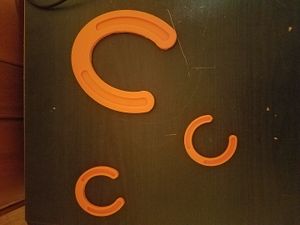
Horseshoes may seem like a fairly common thing, but in third world, or developing countries, access to correctly sized, or new horseshoes can be extremely difficult. The goal is to provide any number of farmers, herders, or others access to custom, new horseshoes. While horses and other hooved animals have rather sturdy feet, it can be important to protect them from the environment, especially if they are going to be used for labor, or put under any kind of stress. These horseshoes can be modified for use with many different kinds of animals. Online, proper metal horseshoes can be found for as little as 3$. These printed shoes can be created for less than a dollar on average. Thus the cost savings for this product scales directly with the number of animals that need shoes. Of course, these shoes will need to be replaced much more often than metal horseshoes, so it is possible that some time will be lost that way.
Bill of Materials for Open Source Horseshoes[edit | edit source]
- The Horseshoes are made entirely of plastic.
- Hardware to mount the Horseshoes. This can be reused in multiple mountings.
- All files (FreeCAD design, and basic stl), as well as instructions are hosted at MyMiniFactory.
Tools needed for fabrication of the Open Source Horseshoes[edit | edit source]
- MOST Delta RepRap or similar RepRap 3-D printer
- Tools for attaching Horseshoes
- Measurement Device
- Some form of heat source is recommended to melt holes for mounting, though, mounting could also be achieved by simply driving the hardware through the plastic.
Skills and Knowledge Necessary to Make the Open Source Horseshoes[edit | edit source]
- Ideally, the ability to access and edit FreeCAD files. Though, this could be done through an intermediary, or, standardized sizes could be created.
Technical Specifications and Assembly Instructions[edit | edit source]
- Measurements of the animal's hoof should be taken.
- From there, one can easily edit the FreeCAD file to suit their individual use-case.
- Additionally, mounting slots can be edited as well.
- Printing should be done at 100% infill for maximum stability.
- It is recommended to use a hydrophobic material like PETG. Or, to treat other materials to better resist the elements.
Common Problems and Solutions[edit | edit source]
- The largest problem currently faced is that these horseshoes have yet to be implemented or tested in the real world.
- The effectiveness, and reliability of the horseshoes with vary dramatically based on the material used the print them, as well as the treatments used after printing.
Cost savings[edit | edit source]
- Cost of the plastic used on the largest sample = $0.10
- Cost of High Quality Horseshoes = $3.00
- Total Savings = $2.90 or a 97% savings